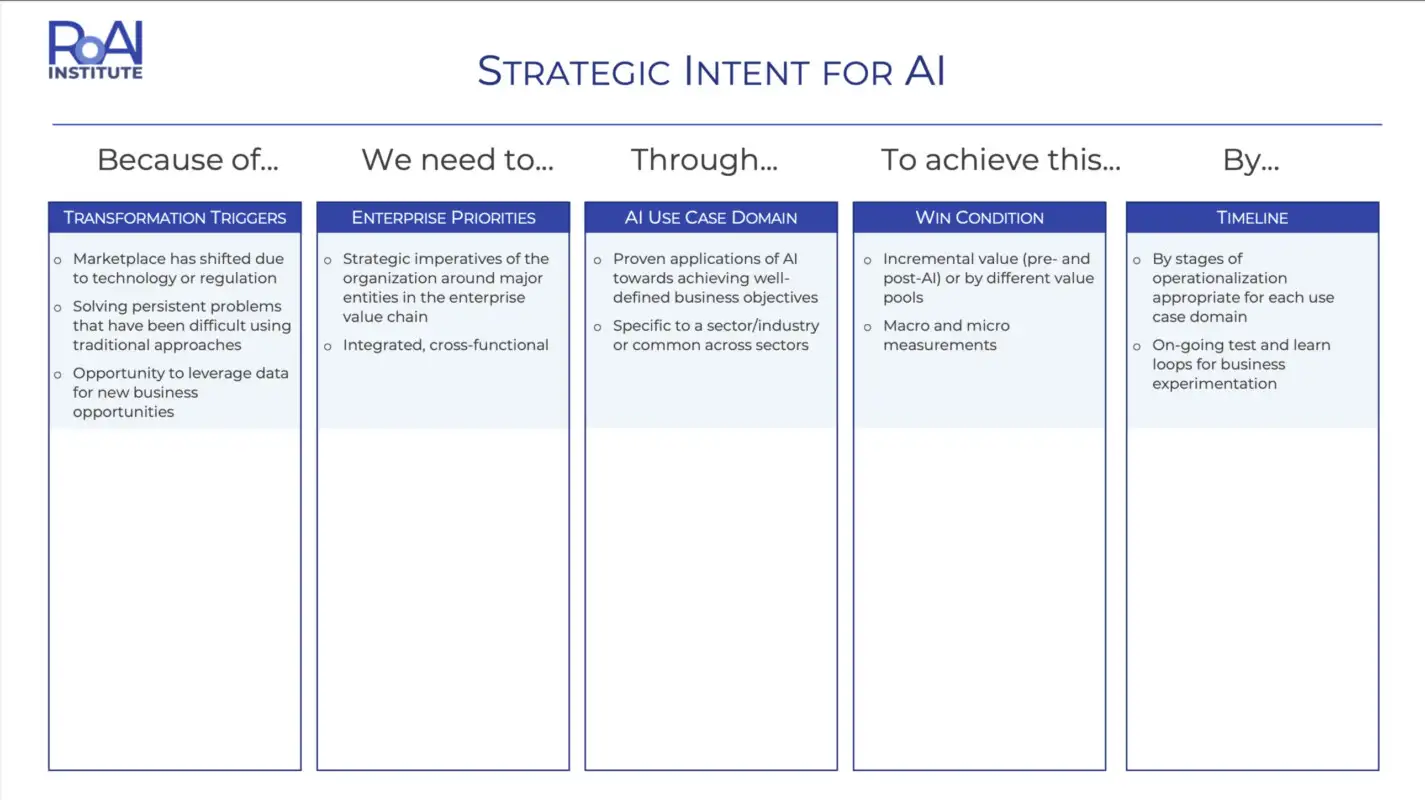Our research of 100+ companies found that defining your strategic intent is key to moving your team forward and out of pilot purgatory.
Picture this: You’re standing at the edge of a vast, uncharted territory. The landscape before you is filled with promise but also fraught with potential pitfalls.
This is the world of artificial intelligence for many business leaders today. They lack a guiding north star on this journey.
AI isn’t just another item on the tech buzzword bingo card anymore.
It’s a game-changer that’s reshaping industries faster than you can say “machine learning.” But here’s the kicker – while everyone’s talking about AI, only a handful of companies are truly harnessing its power to drive real business value.
So, what separates the AI success stories from the expensive science experiments?
It all comes down to one critical factor: Strategic Intent for AI.
The Significance of Strategic Intent in AI Initiatives
Strategic intent in AI is the cornerstone of successful AI implementation. But what exactly does it mean, and why is it so crucial?
At its core, strategic intent for AI is about your AI ambition. It is about aligning your AI initiatives with your broader company goals and vision. It’s the deliberate commitment to AI as a tool for achieving specific business objectives rather than pursuing AI for its own sake.
This approach ensures that your AI projects are technologically impressive and directly contribute to your organization’s success. It is an opportunity statement that will allow leaders to describe the ‘why’ behind the selected AI Intent so the leadership team can communicate compellingly and consistently to the rest of the organization.
Why Strategic Intent Matters
- Focused Resource Allocation: By clearly defining your strategic intent, you can prioritize AI projects that align with your most pressing business needs, ensuring efficient use of resources.
- Reduced Organizational Friction: A well-articulated AI strategy helps build consensus across different departments, reducing resistance to change and fostering a collaborative environment.
- Accelerated Value Realization: With a clear direction, your organization can move from concept to implementation more quickly, accelerating the path to capturing value from AI investments.
- Enhanced Stakeholder Buy-in: A strategic approach to AI demonstrates to stakeholders – from board members to employees – that AI initiatives are not just experimental but integral to the company’s future.

The Risks of Stumbling into AI
Without a clear strategic intent, organizations risk:
- Investing in AI projects that don’t address core business needs
- Creating siloed AI initiatives that fail to deliver enterprise-wide benefits
- Struggling to scale successful pilots due to lack of organizational alignment
- Eroding trust in AI capabilities due to poorly defined or unrealistic expectations
Key Components of Defining Strategic Intent for AI
Defining your strategic intent for AI requires thoughtful consideration and should be approached with the same methodic discipline as other critical business decisions.
Drawing from the HBR article by Gary Hamel and C.K. Prahalad, we can understand strategic intent as:
- The essence of winning
- Stable over time
- A target that deserves personal effort and commitment
Here is a worksheet that you can use with your leadership team to develop your strategic intent for AI.

With this in mind, let’s explore the key components of defining strategic intent for AI:
1. Transformation Triggers
Start by considering the factors that are driving your need for AI transformation. These might include:
- Shifts in the marketplace due to technology or regulation
- Persistent problems that have been difficult to solve using traditional approaches
- Opportunities to leverage data for new business opportunities
Understanding these triggers will help you articulate why AI is crucial for your organization’s future success.
2. Enterprise Priorities
Next, identify the strategic imperatives of your organization. These should be integrated, cross-functional priorities that span the major entities in your enterprise value chain. Ask yourself:
- What are our organization’s top strategic goals?
- How can AI support or accelerate these priorities?
3. AI Use Case Domains
Identify specific domains where AI can be applied to achieve well-defined business objectives. These could be:
- Sector or industry-specific applications
- Common applications across various sectors
For example, a retail company might focus on personalized customer experiences, while a manufacturing firm might prioritize supply chain optimization.
4. Win Conditions
Define what success looks like for your AI initiatives. This could be measured by:
- Incremental value (pre- and post-AI implementation)
- Different value pools impacted by AI
- Macro and micro measurements of success
Be specific about the outcomes you expect AI to deliver.
5. Timeline
Establish a realistic timeline for your AI initiatives. Consider:
- Stages of operationalization appropriate for each use case domain
- Ongoing test and learn loops for business experimentation
Remember, AI implementation is often an iterative process, so build in flexibility for adjustments along the way.
By addressing these components, you can create a comprehensive strategic intent for AI that aligns with your broader business goals, addresses specific challenges and opportunities, and sets clear expectations for success.
Examples of Strategic Intent in AI
Starbucks: Enhancing Customer and Partner Experiences through AI

“To leverage the power of AI and data-driven insights to personalize customer interactions, optimize store operations, and support our partners. Deep Brew, our AI platform, enables us to deliver customized recommendations, efficient labor allocation, and precise inventory management, ensuring every customer enjoys a uniquely personal and seamless experience. By integrating AI across our business, we aim to enhance human connections, improve operational efficiencies, and drive sustainable growth in the digital era.”
JPMorgan Chase (Banking)

“To become an AI-first institution by transforming capabilities across all four layers of our integrated capability stack—engagement, AI-powered decision-making, core technology, and operating model. This holistic approach will enable us to provide distinctive omnichannel experiences, support at-scale personalization, and drive rapid innovation cycles essential for competitiveness.”
Sanofi:

“Our AI ambition is: We’re all in on AI. We want to become the first biopharma company powered by AI at scale. We invest in AI that makes a difference for our people, patients, and partners.”
In each of these examples, the strategic intent clearly aligns AI initiatives with corporate business objectives, providing a clear direction for AI implementation.
Conclusion: Set your team on the right path to advance your AI journey
Defining your strategic intent sets the foundation for all your AI initiatives, ensuring they’re aligned with your business goals, have broad organizational support, and are positioned to deliver tangible value.
As you embark on or continue your AI journey, take the time to step back and critically examine your strategic intent.
- Are your AI initiatives truly aligned with your broader business objectives?
- Have you involved key stakeholders in defining your AI strategy?
- Do you have a clear vision for how AI will be implemented and measured within your organization?
By prioritizing strategic intent, you can navigate the complexities of AI adoption with greater confidence and clarity. Remember, the goal isn’t just to implement AI – it’s to leverage AI as a powerful tool for achieving your business objectives and driving long-term success.
